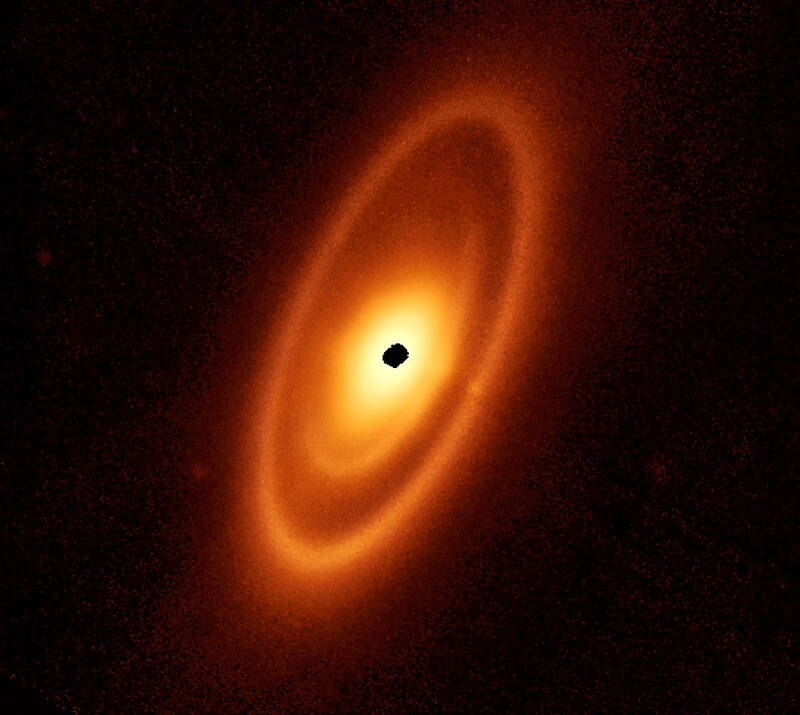There has been plenty of excitement in recent decades about planets detected orbiting various stars beyond our solar system. However, planets provide an incomplete picture of the complex framework that exists around stars, leaving out components like the belts of rocky and icy debris orbiting the sun.
Scientists on Monday unveiled observations by the James Webb Space Telescope showing new details about such features around a luminous star called Fomalhaut in the Milky Way galaxy. These observations of three concentric dusty rings of debris orbiting Fomalhaut provide the fullest view to date of such structures outside the solar system.
Fomalhaut, one of the brightest stars in our night sky and the brightest in the southern constellation Piscis Austrinus, is 25 light years from Earth.

Photo: Reuters
Astronomers first discovered a single belt of debris around Fomalhaut in 1983. Webb’s observations revealed two additional rings nearer the star — a bright inner one and a narrow intermediate one.
These three belts appear to be populated by objects called planetesimals, some of which are thought to join together early in a star system’s history to form planets while others remain as debris like asteroids and comets.
“Much like our solar system, other planetary systems harbor disks of asteroids and comets — leftover planetesimals from the epoch of planet formation — that continuously grind themselves down to micron-sized particles via collisional interactions,” said University of Arizona astronomer Andras Gaspar, lead author of the study published in the journal Nature Astronomy.
Fomalhaut is 16 times more luminous than the sun and almost twice as massive.
The three nested belts extend out to 22.5 billion kilometers from Fomalhaut, about 150 times the distance of Earth to the sun.
While no planets have been discovered yet around Fomalhaut, the researchers suspect the belts were carved out by gravitational forces exerted by unseen planets.
Our solar system has two such belts — the main asteroid belt between the rocky planet Mars and the gas giant Jupiter, and the Kuiper belt beyond the ice giant Neptune.
The gravitational influence of Jupiter, our solar system’s largest planet, corrals the main asteroid belt. The inner edge of the Kuiper belt, which is home to dwarf planets Pluto and Eris, as well as other icy bodies of varying sizes, is shaped by the outermost planet Neptune.
“The secondary gap we see in the system is a strong indication for the presence of an ice giant in the system,” Gaspar said.
The observations from Webb, which was launched in 2021 and began collecting data last year, were made by its Mid-Infrared Instrument (MIRI).
“Nearly all of the resolved images of debris disks thus far had been for the cold, outer regions analogous to the solar system’s Kuiper belt,” like Fomalhaut’s outer belt, said astronomer and study coauthor Schuyler Wolff of the University of Arizona’s Steward Observatory.
MIRI now can resolve the relatively warmer belts of material analogous to our main asteroid belt, Wolff said.
Studying these debris belts offers insight into planetary beginnings.
“Planets form within the primordial disks surrounding young stars. Understanding this formation process requires a complete understanding of how these disks form and evolve,” Wolff said.
“There are many open questions about how the dust in these disks coalesces to form planetary embryos, how the planetary atmospheres form, et cetera,” Wolff said.
“Debris disks are remnants of this planet formation process and their structure can provide valuable clues to the underlying planet population and the dynamical histories,” he added.

A new online voting system aimed at boosting turnout among the Philippines’ millions of overseas workers ahead of Monday’s mid-term elections has been marked by confusion and fears of disenfranchisement. Thousands of overseas Filipino workers have already cast their ballots in the race dominated by a bitter feud between President Ferdinand Marcos Jr and his impeached vice president, Sara Duterte. While official turnout figures are not yet publicly available, data from the Philippine Commission on Elections (COMELEC) showed that at least 134,000 of the 1.22 million registered overseas voters have signed up for the new online system, which opened on April 13. However,

ALLIES: Calling Putin his ‘old friend,’ Xi said Beijing stood alongside Russia ‘in the face of the international counter-current of unilateralism and hegemonic bullying’ Chinese President Xi Jinping (習近平) yesterday was in Moscow for a state visit ahead of the Kremlin’s grand Victory Day celebrations, as Ukraine accused Russia’s army of launching air strikes just hours into a supposed truce. More than 20 foreign leaders were in Russia to attend a vast military parade today marking 80 years since the defeat of Nazi Germany in World War II, taking place three years into Russia’s offensive in Ukraine. Putin ordered troops into Ukraine in February 2022 and has marshaled the memory of Soviet victory against Nazi Germany to justify his campaign and rally society behind the offensive,

ENTERTAINMENT: Rio officials have a history of organizing massive concerts on Copacabana Beach, with Madonna’s show drawing about 1.6 million fans last year Lady Gaga on Saturday night gave a free concert in front of 2 million fans who poured onto Copacabana Beach in Rio de Janeiro for the biggest show of her career. “Tonight, we’re making history... Thank you for making history with me,” Lady Gaga told a screaming crowd. The Mother Monster, as she is known, started the show at about 10:10pm local time with her 2011 song Bloody Mary. Cries of joy rose from the tightly packed fans who sang and danced shoulder-to-shoulder on the vast stretch of sand. Concert organizers said 2.1 million people attended the show. Lady Gaga

CONFLICTING REPORTS: Beijing said it was ‘not familiar with the matter’ when asked if Chinese jets were used in the conflict, after Pakistan’s foreign minister said they were The Pakistan Army yesterday said it shot down 25 Indian drones, a day after the worst violence between the nuclear-armed rivals in two decades. Pakistani Prime Minister Shehbaz Sharif vowed to retaliate after India launched deadly missile strikes on Wednesday morning, escalating days of gunfire along their border. At least 45 deaths were reported from both sides following Wednesday’s violence, including children. Pakistan’s military said in a statement yesterday that it had “so far shot down 25 Israeli-made Harop drones” at multiple location across the country. “Last night, India showed another act of aggression by sending drones to multiple locations,” Pakistan military spokesman Ahmed